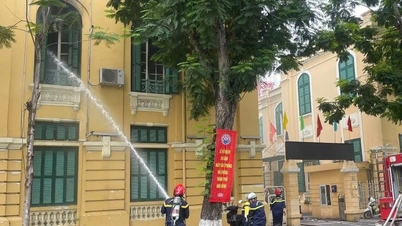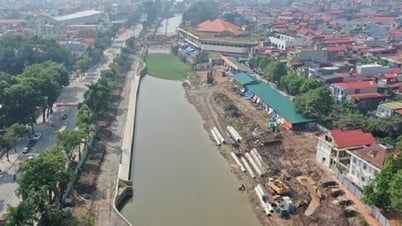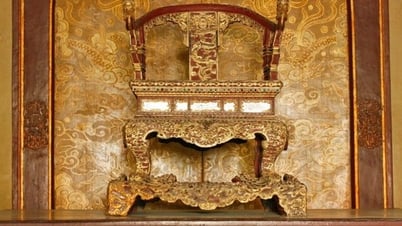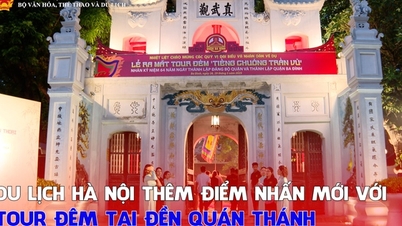Recently, the Department of Culture, Sports and Tourism of Bac Ninh (Department of Culture, Sports and Tourism) has reported the initial results and solutions for researching, preserving and promoting the value of ancient boat relics discovered in Cong Ha quarter, Ha Man ward, Thuan Thanh town, Bac Ninh province.
Talking about the process of discovering ancient boats, Mr. Hach said that in January 2025, during the process of land reclamation for fish farming, Mr. Nguyen Van Chien (born in 1975) discovered traces of 02 ancient boats in Cua Nghe field, Cong Ha quarter, Ha Man ward, Thuan Thanh town, Bac Ninh province, at a depth of about 2m compared to the surrounding rice fields.
Immediately after receiving the information, the Department of Culture, Sports and Tourism invited and coordinated with experts from the Institute of Archaeology to survey and evaluate. Initial assessment shows that this is an ancient boat relic located on the Dau River, which is authentic evidence to evaluate the position and role of the Dau River in the historical flow with Luy Lau citadel and historical periods.
After a period of urgent excavation, the ancient boat relic has revealed all traces, through which the entire scale, structure, materials and manufacturing techniques of the boat can be identified.
From the results of the emergency excavation at the site, on March 26, 2025, the Department of Culture, Sports and Tourism coordinated with the Institute of Archaeology to organize a Field Conference to assess the initial value and propose further solutions for protection, emergency conservation, research and long-term conservation to promote the value of the relic, with the participation of leading experts from the Institute of Archaeology (experts in underwater archaeology), Vietnam Archaeological Association, Institute of History, National Museum of History, Southeast Asian Prehistoric Research Center, Vietnam Shipbuilding Association, ... and managers: Department of Cultural Heritage ( Ministry of Culture, Sports and Tourism ), Department of Culture, Sports and Tourism, Department of Construction, Department of Finance, representatives of Thuan Thanh Town government, Ha Man ward and Cong Ha residential group, where the relic was discovered.
Initial assessment of the value, from the scale, structure, technique and construction materials, shows that this is a type of catamaran, the traces discovered at the scene are the two remaining hulls, this part in technical terms is called the water-displacing part, that is, the structure is completely submerged under water, with the function of two buoys supporting the entire structure above. The structure above has been completely lost, possibly due to being dismantled. This could be a boat with the function of transporting goods, but it could also be a boat used for river or river-sea cruising.
The uniqueness and uniqueness of the boat is that it is built entirely of wood, with absolutely no use of metal in the structural and connecting parts of the boat. Based on documents about ancient boats in Vietnam and around the world, scientists have assessed this as a boat relic with the largest scale, structure and most complex techniques, the only one discovered so far, not only in Vietnam but also internationally. Especially in the connecting structure of the bow and stern of the boat with the boat body, specifically in the connecting block between the dugout at the bottom and the raised planks at the bow and stern, which has never been seen anywhere else in the world.
Regarding the age, scientists all agree that the specific age will await the results of the analysis, but based on the technique, this type of boat often dates back to early times and can be built in Vietnam, a continued development of the boat building technique of the Dong Son culture through comparing the bottom of the two hulls with the dugout structure (made from a tree trunk) and the mortise and tenon technique.
Based on Chinese and international boat documents, it is believed that the boats date from the 11th to the 14th century (Ly and Tran dynasties), and cannot be later than the 15th century and have technical influence from the south.
According to Mr. Hach, documents also mentioned this type of boat, built by the king. The book Viet Su Luoc recorded "In 1106 (Ly Dynasty) ... the king ordered the construction of the Vinh Long boat with two bottoms"; The book Dai Viet Su Ky Toan Thu recorded "In 1124 (Ly Dynasty) ... the king ordered the construction of the Tuong Quang boat, a two-bottom boat". Notably, the original Chinese characters "bottom" and "bottom" have the same form - 腹 (Phuc means belly), meaning a two-bottom boat. Thus, although there are no results of chronological analysis, it is possible to confirm the presence of this type of boat in Vietnamese history, specifically during the Ly Dynasty, through historical records.
Source: https://baophapluat.vn/di-tich-thuyen-co-doc-dao-o-bac-ninh-co-tu-thoi-nha-ly-post547411.html



![[Photo] Prime Minister Pham Minh Chinh receives leaders of Excelerate Energy Group](https://vphoto.vietnam.vn/thumb/1200x675/vietnam/resource/IMAGE/2025/5/29/c1fbe073230443d0a5aae0bc264d07fe)
![[Photo] Prime Minister Pham Minh Chinh meets with Hungarian President Sulyok Tamas](https://vphoto.vietnam.vn/thumb/1200x675/vietnam/resource/IMAGE/2025/5/29/dbcaa73e92ea4448a03fe1d0de6d68e8)

![[Photo] Vietnamese and Hungarian leaders attend the opening of the exhibition by photographer Bozoky Dezso](https://vphoto.vietnam.vn/thumb/1200x675/vietnam/resource/IMAGE/2025/5/29/94d8ceca5db14af3bf31285551ae4bb3)























































































Comment (0)